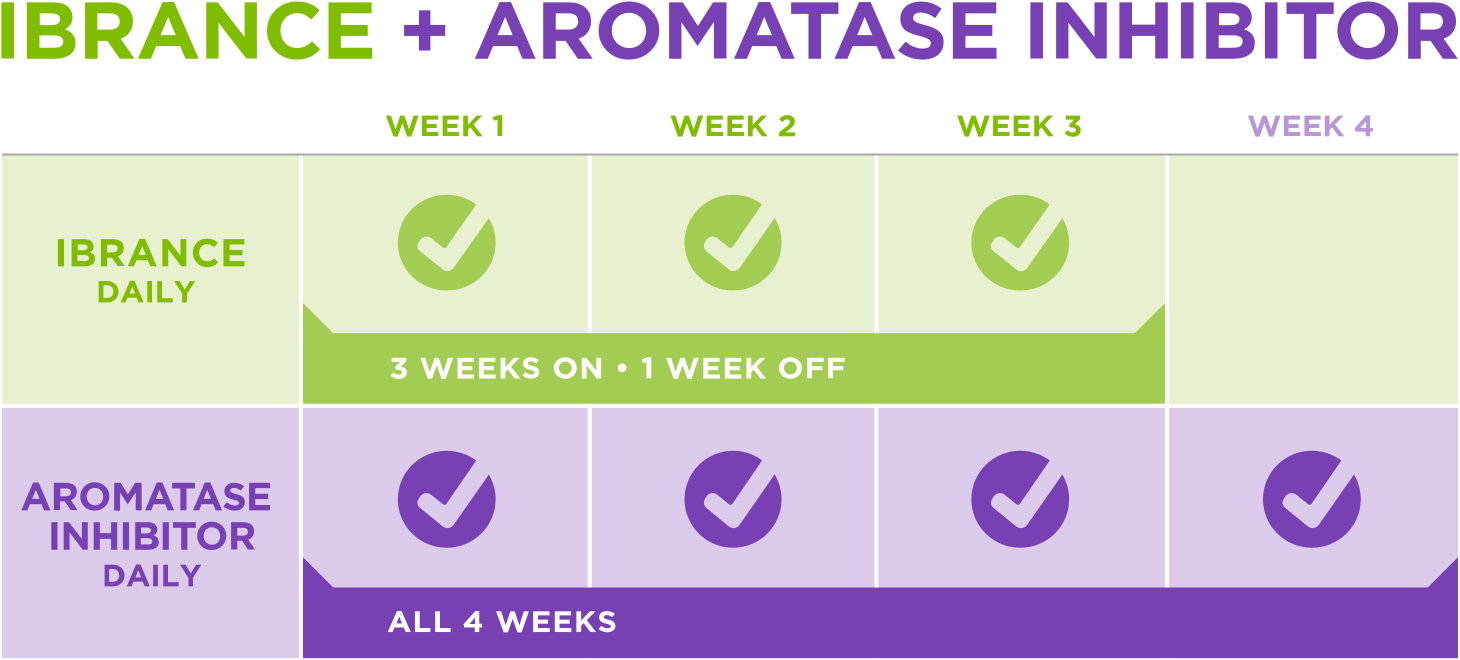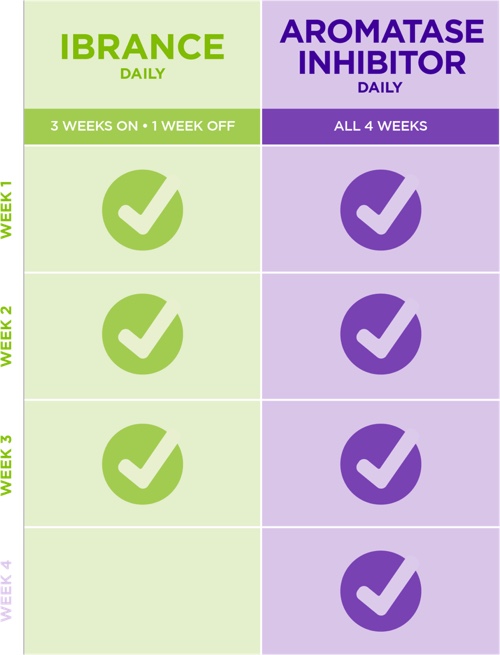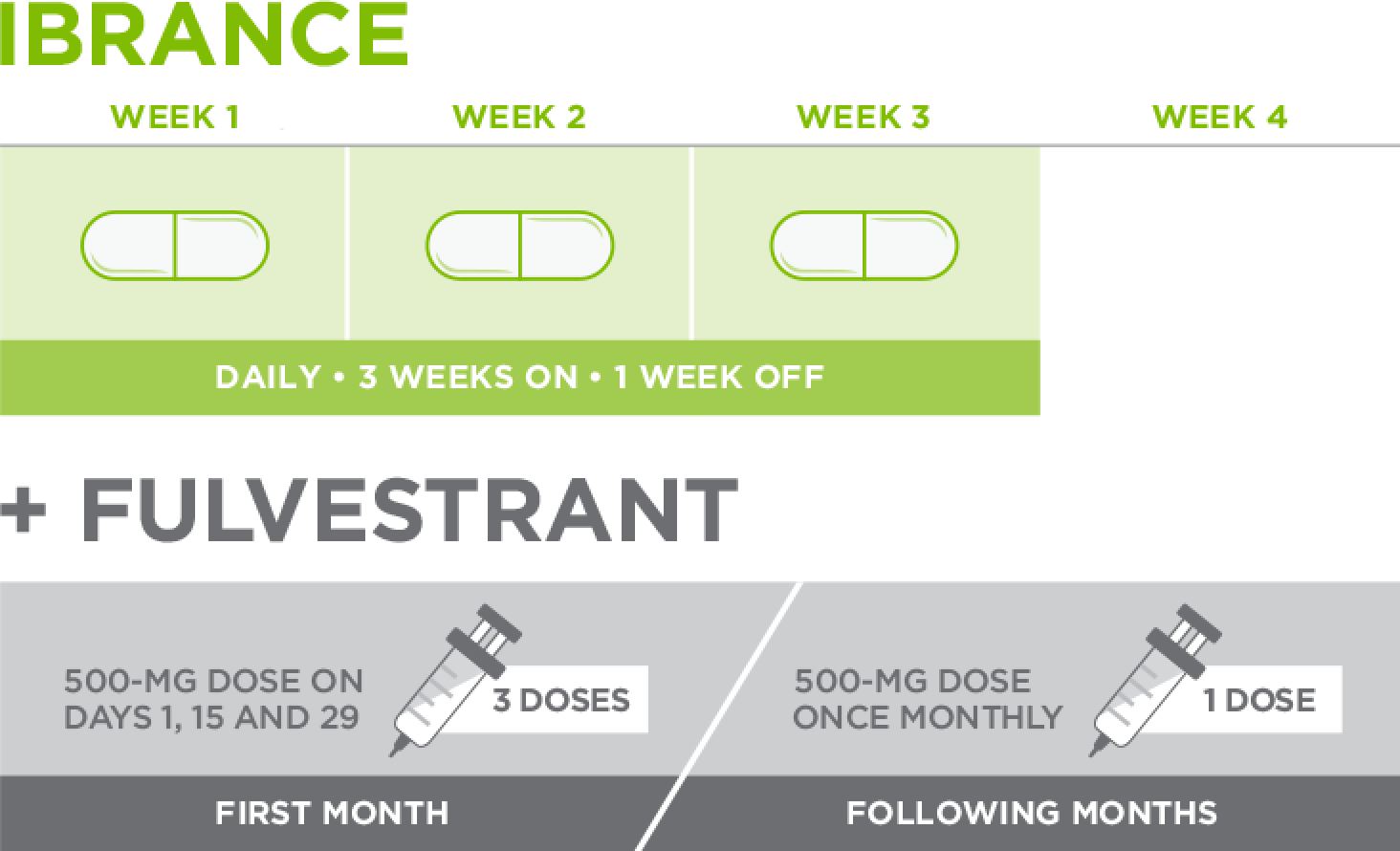Still have questions we haven't answered?
Click here for the Pfizer medical information website.
Where can I get IBRANCE?
IBRANCE is a prescription product that is available through your local pharmacies and is now funded (certain criteria apply) for New Zealand women diagnosed with a common and incurable type of advanced breast cancer.11
IBRANCE is taken with a hormonal therapy to treat hormone receptor positive (HR+), human epidermal growth factor receptor 2-negative (HER2-) advanced breast cancer.1
Women may use IBRANCE in combination with any aromatase inhibitor1.Click here to learn more.
Alternatively, women who have previously received endocrine therapy for their disease may take IBRANCE together with fulvestrant1.Click here to learn more.
Women who haven’t been through menopause may also receive a luteinizing hormone releasing agonist in combination with endocrine therapy.1



IBRANCE and an aromatase inhibitor are taken orally in a 4-week cycle.1,18-20 For the first 3 weeks (21 days), you‘ll take one IBRANCE and one aromatase inhibitor pill every day.1,18-20 Then for the last week (7 days), you’ll take only one pill — an aromatase inhibitor.1,18-20 At the end of 4 weeks, the cycle will start over again.1 Your healthcare team will monitor your therapy17 throughout.
Even though you’ll stop taking IBRANCE for the last week of each cycle, your aromatase inhibitor should be taken every day throughout your therapy18-20 . It should even be taken if your healthcare team stops your treatment with IBRANCE or adjusts your dose.1
If you haven’t been through menopause, you may also be given a luteinizing hormone releasing agonist to use in combination with your aromatase inhibitor.1

IBRANCE is taken orally over a 4-week cycle.1 For the first 3 weeks (21 days), you‘ll take one IBRANCE pill every day.1 Then for the last week (7 days), you won’t take IBRANCE.1 At the end of 4 weeks, the cycle will start over again.1 Your healthcare team will monitor your therapy throughout.17
Fulvestrant is an intramuscular injection that is administered by your healthcare team on days 1, 15, and 29 of the first month. Then after that, it will be a single dose once a month as shown in the chart above.1 You should discuss how you will take fulvestrant with your healthcare team, and be sure to follow all their directions carefully.17
If you haven’t been through menopause, you may also receive a luteinizing hormone releasing agonist in combination with fulvestrant.1
Remember, communication is key.
Your healthcare team will prescribe IBRANCE in combination with either an aromatase inhibitor or fulvestrant.
Before taking IBRANCE, it’s important to talk to your healthcare team about any health issues or other medications you’re taking, including prescription medicines, over-the-counter medicines, vitamins and herbal supplements.17 IBRANCE and other medicines may affect each other and cause side effects.17
Additionally, tell your healthcare team if you have: fever, chills, or any other signs or symptoms of infection; liver or kidney problems; are lactose intolerant; and/or any other medical conditions.17
Tell your healthcare team if you are pregnant or plan to become pregnant; IBRANCE can harm your unborn baby.17 Females who are able to become pregnant and who take IBRANCE should use effective birth control during treatment and for at least 1 month after stopping treatment.17 Males who are taking IBRANCE and have female partners who can become pregnant should use effective birth control during treatment with IBRANCE and for 14 weeks after the final dose of IBRANCE.17
Tell your healthcare team if you are breastfeeding or plan to breastfeed;17 it is not known if IBRANCE passes into your breast milk.1 Work with your healthcare team to decide if you will take IBRANCE or breastfeed. You should not do both.17
This medicine may cause fatigue and blurred vision in some people. If you have any of these symptoms, do not drive, operate machinery or do anything else that could be dangerous.
To monitor side effects, your healthcare team will take some blood tests to check your complete blood cell count. This will happen before you start taking IBRANCE, and at the beginning of every cycle as needed.1
Additionally, for the first 2 treatment cycles, you'll need a blood test to check your complete blood cell count on day 15 as well.1 Make sure to tell your healthcare team which day you start your first and second cycles so they can schedule your day 15 appointment at the right time.
Remember, it is vital you get your blood tests done on time. We understand that you may feel anxious at these times, but it is important to understand that you are not alone and your healthcare team are there to support you.
If your results indicate low white blood cell counts (neutropenia), your healthcare team may temporarily hold or adjust your dose.1 Many people have their doses modified during treatment.1 Be sure to follow your dosing schedule exactly as your healthcare team prescribes.17
We have also developed a programme called CareMate mBC. When you start your therapy, it can feel a bit overwhelming as you adjust to your new treatment. CareMate mBC is here to help support and manage different aspects of your treatment, like reminding you when to take your medication. To find out more click here
Below are some tips that you might find useful in managing possible side effects. If you do experience any side effects, make sure you share them with your healthcare team early so that they can help you manage them.21
It’s important to take steps to protect yourself against infection throughout your breast cancer treatment:22
Tell your doctor right away or go to Accident and Emergency at your nearest hospital if you have fever, chills or any other signs or symptoms of infection.17
Wash your hands often.23
Clean vegetables and fruits and store them at the right temperatures.24
Avoid exposure to people who might be sick.23
If you’re feeling sick or are vomiting, it’s best to talk to your healthcare team.25 They can tell you how to deal with your symptoms or may prescribe you medication that can help.25 In addition to their instructions, following the below tips may help you feel better:
Eat small, frequent meals instead of three large ones.26
Try high-calorie foods that are easy to eat (desserts, ice cream, yoghurt, etc.) several times a day.26
Avoid fried food, fatty foods or foods with a strong smell.25
Eat bland foods, such as dry toast or crackers.26
Sip water throughout the day, as dehydration may contribute to nausea.25,26
Use relaxation techniques, such as deep breathing.25
When experiencing nausea, use a distraction such as music, television or talking with friends.26
It’s important to check your mouth and tongue daily for sores, white spots or infections, and inform your healthcare team about any changes right away.22 If you do have a sore mouth, follow these tips:
Avoid tobacco, drinking alcohol, and spicy and acidic foods.22
Eat foods that are soft and easy to chew or swallow.22
If you have mouth pain, sucking on ice cubes or Popsicles® may help.22
It takes a lot to go through treatment, both physically and mentally.27 If you feel tired or weak, following these tips may help:
Maintain a healthy balance between getting enough rest and keeping active.28
Take short naps or breaks.28
Try doing light exercise each day.28 Talk to your doctor about the right exercise plan for you.29
Eat well and drink plenty of fluids.28 Sometimes dehydration can cause tiredness and weakness.24
Support groups may be able to help you manage stress and work through things that are making you tired.29
Take time to unwind by listening to music or reading a good book.28
Don’t forget to consult your healthcare team for advice.28
If you have diarrhoea, tell your healthcare team.30 It’s also important to take a closer look at your diet.22,30 Certain foods and drinks can make diarrhoea worse or better.22 Following these tips may help to alleviate diarrhoea symptoms:
Eat small meals several times a day instead of three big ones.22
Drink 8 to 12 cups of clear liquids each day.22
Avoid dairy products, raw vegetables and spicy foods.22
Avoid drinks with alcohol or caffeine.22
Hair thinning or hair loss may occur.1,31,32 If hair thinning occurs, these tips may help:
Use gentle hair products such as baby shampoos.22
Avoid harsh chemicals like hair dye and chemical straighteners.22
Be gentle when brushing and washing hair.33
Avoid too much hair brushing or pulling (braids or ponytails).33
Avoid using hair dryers, curling tongs and curlers and pat your hair dry.22
Wear a hat or scarf outside to reduce loss of body heat.22
Try a different hairstyle to cover areas of hair thinning or loss.22
IBRANCE is a prescription breast cancer medicine used to treat hormone receptor-positive (HR+), human epidermal growth factor receptor 2-negative (HER2-) breast cancer that has spread to other parts of the body (advanced).1 It is taken in combination with:
an aromatase inhibitor or
fulvestrant in women who have received prior endocrine therapy.1
Women who haven’t been through menopause may also receive a luteinizing hormone releasing agonist in combination with endocrine therapy.1
Talk to your healthcare team to see if IBRANCE is right for you.
IBRANCE may cause side effects, including:
Low white blood cell counts (neutropenia).17 Low white blood cell counts are very common when taking IBRANCE and may cause serious infections that can lead to death.1 Your doctor should check your white blood cell counts before and during treatment.1
These side effects may be serious and you may need urgent medical attention or hospitalisation.17
For more information, see side effects
Before you take IBRANCE, tell your doctor if you:
have fever, chills, or any other signs or symptoms of infection.17
have liver or kidney problems.17
have any other medical conditions.17
are pregnant or plan to become pregnant; IBRANCE can harm your unborn baby.17
Females who are able to become pregnant and who take IBRANCE should use effective birth control during treatment and for at least 1 month after stopping IBRANCE.17
Males who are taking IBRANCE and have female partners who can become pregnant should use effective birth control during treatment with IBRANCE and for 14 weeks after the final dose of IBRANCE.17
are breastfeeding or plan to breastfeed;17 it is not known if IBRANCE passes into your breast milk.1 You and your doctor should decide if you will take IBRANCE or breastfeed. You should not do both.17
Yes. To monitor your side effects, your healthcare team will give you a blood test to check your complete blood cell count before you start taking IBRANCE and at the beginning of every cycle.1 It is important that you don’t delay having your blood tests and that you have your blood tests done on time.
Additionally, for the first 2 treatment cycles, you'll need a complete blood cell count done on day 15 as well.1 Make sure to tell your healthcare team which day you start your first and second cycles, so they can schedule your day 15 appointment at the right time.
If your results indicate low white blood cell counts (neutropenia), your healthcare team may temporarily hold or adjust your dose.1 It's not uncommon to have doses modified throughout treatment.1 Be sure to follow your dosing schedule exactly as your healthcare team prescribes.17
Find side effect information and tips here
Alopecia (hair thinning or hair loss) is a possible side effect of IBRANCE.1 The majority of women who experience alopecia have hair thinning rather than hair loss.31,32
Hormone receptor-positive (HR+) is a subtype of breast cancer that includes both estrogen receptor-positive (ER+) and/or progesterone receptor-positive (PR+) subtypes and grows in response to 2 different hormones—estrogen and/or progesterone.4 If your cancer grows in response to the hormone estrogen, your cancer could also be called ER+.4 If your cancer grows in response to the hormone progesterone, it could be called PR+.4
A CDK 4/6 inhibitor is a type of treatment that works to slow down cell growth and division by preventing certain proteins (called CDK 4 and CDK 6) from telling the cell that it needs to grow and divide.1,15
IBRANCE is a CDK 4/6 Inhibitor that does this in both healthy and cancer cells.1 This helps slow the progression of cancer, but it can also cause side effects, some of which are serious.1
No, breast cancer can spread regardless of treatment or preventative measures taken.34
Yes, check out our resources here
Click here for the Pfizer medical information website.
Disclaimer: You are now leaving IBRANCE.co.nz. The information on the external website may not comply with the New Zealand legislation or advertising codes. Further information relevant to the New Zealand environment is available from Pfizer’s website www.pfizer.co.nz.
Disclaimer: You are now leaving Ibrance.co.nz to another Pfizer website. Further information relevant to the New Zealand environment is available from the Pfizer website www.Pfizer.co.nz.